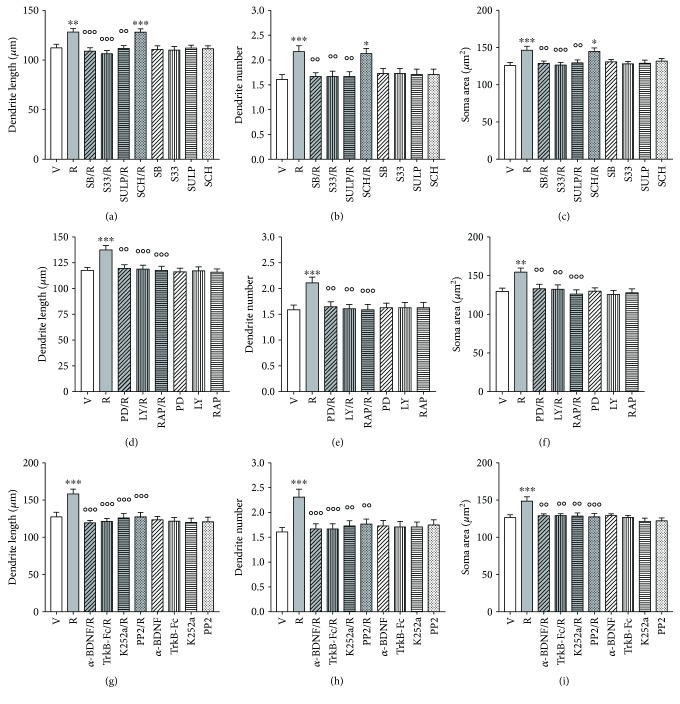Figure 4.
Structural plasticity induced by ropinirole in human iPSC-derived DA neurons is prevented by D3R antagonists, by MEK-ERK and PI3K-mTOR inhibitors and by BDNF-TrkB signaling inhibitors. (a–c) Inhibition of the effects of ropinirole (10 μM) on structural plasticity of F3 DA neurons following pretreatment (20 min) with the D3R antagonists SB277011-A (50 nM) and S33084 (10 nM) or the D2/D3R antagonist sulpiride (5 μM) assessed as (a) maximal dendrite length, (b) number of primary dendrites, and (c) soma area after 72 hrs. Pretreatment (20 min) with the D1R antagonist SCH23390 (1 μM) was ineffective. (d–f) Inhibition of the effects of ropinirole (10 μM) on structural plasticity of F3 DA neurons following pretreatment (20 min) with PD98059 (10 μM), LY294002 (10 μM), or rapamycin (20 nM), assessed as (d) maximal dendrite length, (e) number of primary dendrites, and (f) soma area after 72 hrs. (g–i) Inhibition of the effects of ropinirole (10 μM) on structural plasticity of F3 DA neurons following pretreatment (20 min) with an anti-BDNF blocking antibody (α-BDNF) (10 μg/ml), a TrkB-Fc Chimera (TrkB-Fc) (5 μg/ml), the TrkB-phosphorylation inhibitor K252a (200 nM), and the TrkB-Src phosphorylation inhibitor PP2 (10 μM), assessed as (g) maximal dendrite length, (h) number of primary dendrites, and (i) soma area after 72 hrs. When antagonists and inhibitors were tested with the vehicle, no changes of structural plasticity were visualized. In all panels, values are represented as mean ± SEM (∗∗∗ p < 0.001, ∗∗ p < 0.01, and ∗ p < 0.05 versus vehicle; °°°p < 0.001 and °°p < 0.01 versus ropinirole; post hoc Bonferroni's test). V, vehicle; R, ropinirole; SB, SB277011-A; S33, S33084; SULP, sulpiride; SCH, SCH23390; PD, PD98059; LY, LY294002; RAP, rapamycin, α-BDNF, anti-BDNF blocking antibody; TrkB-Fc, TrkB-Fc Chimera.

